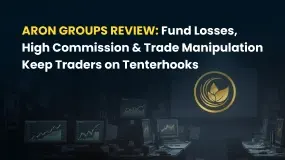简体中文
繁體中文
English
Pусский
日本語
ภาษาไทย
Tiếng Việt
Bahasa Indonesia
Español
हिन्दी
Filippiiniläinen
Français
Deutsch
Português
Türkçe
한국어
العربية
Types of trends in technical analysis
Abstract:When entering the world of investment to operate financial products, it is essential to educate our knowledge, making it progressive and gradual. In technical analysis there is nothing more basic and essential than identifying the trend in which we are going to operate. Regardless of the terms in which we want to do it (long, medium or short) it is essential to identify the types of trends in technical analysis.

When entering the world of investment to operate financial products, it is essential to educate our knowledge, making it progressive and gradual. In technical analysis there is nothing more basic and essential than identifying the trend in which we are going to operate. Regardless of the terms in which we want to do it (long, medium or short) it is essential to identify the types of trends in technical analysis.
Curiously, the shorter the trading period, the more relevant it will surely be to identify the primary trend in which the traded asset is located. But, before continuing with the different types of trend that we can find in a graph, the first thing is to define it.
What is trend in technical analysis?
The simplest and probably most clarifying definition would be the following: the trend is the direction in which the price of a financial asset evolves over a certain period of time.
It is vitally important to highlight the time frame , since trends can coexist in it, such as a bullish one in the long term with a bearish one in the short term. The important thing about the trend, in order to be able to trade in its favor, is that it is clearly identified .
Traders with many years of experience know this and it is the first thing they usually look at. It is much more productive to ride the “wave” of the inertia of the trend in which you want to move , than to try to “predict” the next turn of the market and get ahead of it. This last procedure, in most cases, leads to a substantial decrease in the probability of sustained success over time.
The importance of trend in technical analysis
But why is it so important when operating in the financial markets? There is an aphorism that precisely exemplifies the importance of visualizing clearly and without doubt the trend of the financial asset in which we are investing: it has to be so obvious that “even a boy or girl is able to know if it goes up or down.” . Once we have defined what a trend is, we can go on to detail the three types of trends that we will find when studying the price graph of the security in which we want to operate.
What are the types of trends?
Like signs on a map, trends guide investors toward informed decisions. The three types of trends in technical analysis are: bullish, bearish and sideways . Let's look at them as an example, selecting one of the products preferred by retail investors: the Micro E-mini S&P 500 Future from the American market .
Three types of trends in technical analysis: bullish, bearish and sideways
Bullish trend
It is one in which in N periods, the asset presents a development in the increasing price structure, with clear increasing maximums and minimums in the graph.
Let's look at an example:

As can be seen, we can draw a clearly ascending arrow on the graph, without it having been pierced at any time.
Bearish trend
It is one in which in N periods, the asset presents a development in the decreasing price structure, with clear decreasing maximums and minimums in the graph.

Example of the bearish trend on the Micro E-mini S&P 500 Future chart
We see in the example in the graph above just the opposite case to the previous one. It is clearly seen how the arrow presents a corrective direction without there being a clear overshoot at any time in the development of the candles..
Lateral trend
Finally, we would have a third type, in which in N periods, the asset presents a price structure without there having been substantial increases or decreases, and similar maximums and minimums can be reflected in this time period. Next, let's look at another example on the Micro E-mini S&P 500 Future:

As can be seen in the blue rectangle drawn, there have been price movements and yet the highs and lows are similar.
Always in continuous training
In conclusion, we should not stop educating ourselves about markets and investment strategies. Always starting with simple and simple concepts, but establishing them well and strongly. And in this sense, technical analysis and trends can serve as a guide when making financial decisions. These currents, whether bullish, bearish or sideways, offer insight into market movements. The ability to discern patterns in highs and lows, draw trend lines, and know how to interpret trends can help a lot during times of uncertainty in the world of investing.

Disclaimer:
The views in this article only represent the author's personal views, and do not constitute investment advice on this platform. This platform does not guarantee the accuracy, completeness and timeliness of the information in the article, and will not be liable for any loss caused by the use of or reliance on the information in the article.
Read more

Apex Markets Review: Traders Outraged Over Withdrawal Denials & Other Trading Issues
Struggling to access fund withdrawals from Apex Markets for months? Does the broker remain silent on fund withdrawal issues? Does the Saint Vincent and the Grenadines-based forex broker reject your winning trades? Have you failed to get a refund into the card used for deposits? Did the broker deduct from your trading account instead? Traders have been imposing these scam allegations while sharing the Apex Markets Review online. We read the reviews and shared some of them below. Take a look!

tastyfx Exposed: Fund Losses, Trade Manipulation & Account Related Hassles Hurt Traders
Are fund losses normal for you at tastyfx? Does the US-based forex broker constantly manipulate prices to hit your trading experience? Do you fail to receive a reply from the broker on your fund withdrawal requests? Do you constantly face trading account issues with tastyfx? It’s time to read the tastyfx review shared by traders online.

Aron Groups Review: Fund Losses, High Commission & Trade Manipulation Keep Traders on Tenterhooks
Have you lost your hard-earned capital while trading via Aron Groups Broker? Has the high commission charged by the broker substantially reduced your trading profits? Does the Marshall Islands-based forex broker constantly manipulate spreads to widen your capital losses? Have you been lured into trading courtesy of Aron Groups No Deposit Bonus, only to find that you had to deposit capital to get a bonus? All these and many more trading issues have become synonymous with the experience of Aron Groups’ traders. Consequently, many traders have shared negative Aron Groups reviews online. In this article, we have shared some of their reviews.

Uniglobe Markets Bonus Review: Understanding the Offers and Uncovering the Risks
Many traders start looking for a new broker by searching for special deals and bonuses. The phrase "Uniglobe Markets no deposit bonus" is something people often search for. Let's address this question clearly and directly. Based on all the information we have, Uniglobe Markets does not currently offer a no-deposit bonus. Instead, this broker focuses on bonuses that require you to deposit your own money first. To get any bonus credits, traders must put in their own capital. Read on to learn how this entire bonus works out for traders.
WikiFX Broker
Latest News
Is Nash Markets Regulated or Risk? Truth About Nash Markets’ License & Withdrawal Issues
Webull Widens Crypto Futures with Coinbase Derivatives
Latest FCA Daily Alerts and Consumer Warnings for 2025
CySEC Blocks Certification Access to Combat Advisor Impersonation
Angel one 2025 Review & Complaints
Exclusive Markets Under the Scanner: Traders Report High Swap Charges, Deposit Discrepancies & More
Voices of the Golden Insight Award Jury - Simon So, Chief Experience Officer of Hantec Financial
PINAKINE Broker Review: A Complete Look at Its Services and Risks
Pinched By Penny Shortage, US Retailers Beg Congress To Step In
PINAKINE Broker India Review 2025: A Complete Guide to Safety and Services
Currency Calculator



